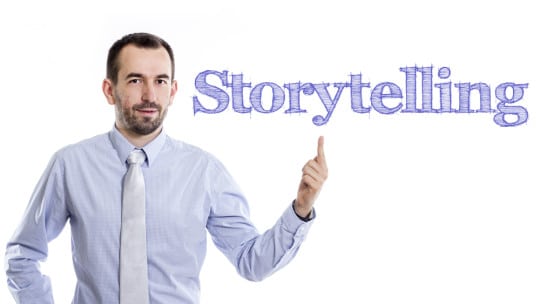
In Washington, D.C., last week it was “All Comey All The Time” as the former FBI director hit the circuit for his book, “A Higher Loyalty,” starting with a special interview on ABC with George Stephanopoulos.
Ask most people what they recall from the interview and others James Comey did last week, and they’re likely to mention parts where he described interacting with President Trump, especially a White House dinner between the two.
There may be far more important material in the 304-page Comey book than the president’s dinner repartee. Still, as Kelly Stone, director of global social media at nonprofit CompTIA, says, “People like to relate to people.” In addition, it was a good story.
Those bits of storytelling wisdom are vital to the positioning turnaround of Microsoft, says Miri Rodriguez, the company’s storyteller. Years ago the stars of Microsoft’s stories were its products and services. Corporations today, she says, “address customers first, not products.” Now Microsoft’s products are “the supporting characters” in its messaging, she says. The protagonists are “empowered people,” doing “great things” with Microsoft products.
For example, a Microsoft video features Ariela Suster, who’s disrupting violence in her home country of El Salvador. The young men she hires to work at her craft company, Sequence, otherwise would be in gangs. Only toward the video’s end do Microsoft products enter the story, as Suster trains young men via Skype so they can avoid moving through dangerous neighborhoods. [https://bit.ly/2HDQoc0]


Storyteller
Microsoft
Another video seems fictional. In it the main characters are two former old friends in India whose grandchildren bring them together using a variety of Microsoft-enabled information technology products. [https://bit.ly/190nJpC]
While Microsoft technology is more apparent in the second video, the old men in the emotionally charged reunion are the story’s center. As Rodriguez says, “[Microsoft and its products] are the sidekicks.” Microsoft wants “to be the narrator…the story is not about us [and our products, it’s about people using them to do wonderful things].”
Pitching content to journalists with relatable people as the core of a story is relatively easy—reporters “eat this stuff up,” she says. With these stories, Rodriguez argues, Microsoft “can be the media instead of having to pitch to the media.”
Another tip: Storytelling works only if the story tells the “right message” across all channels, Rodriguez adds.
5 Elements Journalists Seek

Media Director
Golin
Microsoft’s effort to put relatable people and video upfront tracks with how today’s journalist operates, Jack Barbour, media director at Golin, says. Some 75% of journalists are under pressure to think about how a story will play socially. As a result, stories with relatable people at their center and those with useful images and even video are among five elements reporters are seeking in a story pitch, he says. The others [see infographic on page 1] include: brevity (can the story be told succinctly); localization (is it a story occurring locally or that will be of interest to local readers?); and a proximity to trending topics (stories that can be pegged to breaking news items).
A piece of advice from Barbour also focuses on people and it’s one we’ve not heard expressed quite this way when discussing pitching and storytelling. “Use empathy,” he says. Think about what the journalist does each day and how stressed she is. Then think about how you as a PR person can help relieve some of the stress.

Director of Global Social Media
CompTIA
Barbour’s five elements were on display during a Mountain Dew campaign last year, which had as its focus a commercial introducing fictional NASCAR driver/egotist Dewey Ryder (played by Danny McBride). In an effort to raise awareness for the ad, which had debuted one month prior, and inject Ryder into the zeitgeist and make him the face of the brand, Golin helped roll out additional content, featuring McBride disrupting an ESPN interview with NASCAR driver Dale Earnhardt Jr. Although the interview was bogus, the laughs are real, as ESPN host Kenny Mayne, one of the net’s funniest, plays along with McBride’s Ryder perfectly. Earnhardt Jr. handles himself well too. Also important: The video has very little branding, so is more “coverage-friendly” to journalists. In addition it hooked to a news event: Earnhardt Jr.’s impending retirement.
Golin arranged for ESPN business journalist Darren Rovell to share the video with his 2 million Twitter followers. At that point it was pitched to journalists, offering them photos and footage easily shared on their social accounts.
It then ran as a commercial during a Mayne-hosted 11pm episode of ESPN’s Sports Center. The next morning ESPN shared it with its 13 million Facebook followers.
The Takeaways:
1. Journalists appreciated the creativity of the video campaign and realized running clips and photos from it would enhance their story and create consumer interest.
2. When a topic is niche, such as NASCAR, mainstream talent such as McBride and Mayne can help the pitch.
3. Embrace social media for how journalists can use it (Golin provided clips and photos for media to share), but also how the brand can launch a campaign; for example, it’s important to know the right social platform to use.
4. Follow your instinct, but let data and analytics guide you. Knowing the characteristics and analytics of the platforms helped with the choice of where to launch the video. The 24-hour results included 14 media placements, 40 million media impressions, 700K video views, 2,279 shares and nearly 1,000 comments.
Storytelling on a Budget
What about storytelling and seeking coverage on a far less modest budget? That’s the conundrum of CompTIA’s Stone. “We don’t sell a sexy product…we’re selling a better future.” As a result, the organization’s social marketing relies on storytelling that will “relate to people” as well as useful imagery, she says.
Similar to Barbour, Stone feels strongly about using “the correct” social platforms to relay messages [see chart]; like Rodriguez, she believes a brand must have a consistent message on all its channels. She subscribes to Barbour’s empathy tactic, expressing it slightly differently. “Yes, reporters have quotas…for social media and column inches…so they’re stressed and busy” and most newsrooms are getting smaller, says Stone, a former reporter. As a result, her advice is “Easy does it.” This means, “Be a resource, not a pest on a reporter’s shoulder.” In short, “become a trusted partner in bringing news to their readers.”

Whom to Pitch?
Since Stone is working with small budgets, she feels it’s critical her pitching be efficient. She recommends Klout.com, which helps her find influencers, which are arranged by topic and ranked by their influence, 1-100 (Beyoncé is 100). Tip: See where your brand is ranked. “It can be enlightening,” she says.
She uses SocialRank to learn about her Twitter followers rank. Who among her followers has the most followers? Who is her most avid retweeter? Who is her most active follower? “It’s a great tool to see the landscape,” she says. In addition, Twitter analytics, she says, “is an excellent resource.”
Her mini-case study involves a charitable campaign to assist survivors of Hurricane Harvey. “The goal was a dollar one,” she says. For a catchy pitch, CompTIA decided it would match every donation 2-to-1. Thinking about other pitching elements, Stone’s team found a compelling visual (a man carrying a cooler in knee-deep water) for its Instagram campaign and made asked its most-loyal social followers to contribute. “Using the tools (mentioned above) we knew who our most loyal followers were,” she says. It also created a concise message for other social platforms and a video with CompTIA’s CEO. The campaign raised $236,000 from 700+ donors, she says. The cost was just $700.
CONTACT: @JackMBarbour @MiriRod @KellyCulinarian
